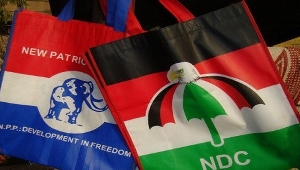- Home - News
- TWI News | TV
- Polls
- Year In Review
- News Archive
- Crime & Punishment
- Politics
- Regional
- Editorial
- Health
- Ghanaians Abroad
- Tabloid
- Africa
- Religion
- Election 2020
- Coronavirus
- News Videos | TV
- Photo Archives
- News Headlines
- Press Release
Opinions of Wednesday, 30 April 2008
Columnist: Ossei, Nana Yaw
An urgent need to think outside the box.
Part 2.
The thrust of my article is to advance a case for the diversification of Ghana’s export commodities by exploiting our comparative advantage in salt and cassava production.
Salt which is popularly called ‘White Gold’ is said to be a universal commodity. Apart from salt being used for cooking, it has other myriad uses such as preservation, production of plastic products, oil refining and production, as component in animal feed production, in
processing and manufacturing and the petrochemical industry. Salt is a valuable
commodity which can be a major addition to Ghana’s export products. Currently, Ghana
produces about 200,000 tonnes of salt per year but potentially, Ghana has the capacity
to produce an estimated 3.0 million tonnes per year. Salt production in Ghana is
produced in the crudest of forms by crystallising seawater near lagoons through solar
energy and wind evaporation methods. Importantly, salt from Ghana is adjudged to be
one of the best on the market and therefore attracts the highest price per tonne.
There is a huge market for salt in the West-Africa sub-region and internationally. In the
West-Africa sub-region, Nigeria potentially presents the biggest export market.. Currently,
Nigeria imports $4.5 billion dollars worth of salt annually and consumes about 60% of
the total salt produced in the West-Africa sub-region. The sad irony is that, Nigeria
imports most of her salt from Brazil, European Union, Saudi Arabia and India. As a
nation, we have failed to take advantage of such huge market potential just around the
corner from us, but rather, we have allowed others far a field to seize the $4.5 billion
dollar per year salt market in Nigeria. If Ghana can build her salt industry, then the huge
Nigerian market will be there for the taking. With better planning and a new strategic
thinking, I see no reason why Ghana cannot capture about 40% of the Nigerian market
over a five year period and this will potentially rake in nearly $2 billion dollars per year.
We need as a matter of urgency diversify our export commodities rather than depend
significantly on cocoa, gold and timber. Diversification of our export commodities equates that, we are diversifying our risks as a nation in that, if cocoa prices depreciate or
production is to fall, we can rely on palm oil or salt to generate revenue for the nation.
Salt production forms partly the basis for the chemical industry and if Ghana is to
develop a chemical industry we cannot afford to overlook the salt industry. Salt forms an
integral input in oil production and since Ghana will begin oil production by 2011, we
need to begin to strategise and look at ways to increase salt production because, in a
couple of years time, there will be a huge demand for salt domestically which may
dramatically increase the price of salt domestically. Some years back, Nigeria decided to
offer Ghana crude oil in exchange of salt. Not only will salt production on a large scale
generate employment opportunities for thousands of Ghanaians but, increase revenue
to the District Assemblies and national government respectively through local and
corporate taxes and finally, generate huge foreign exchange through export of processed
salt.
However, like any other industry in Ghana, the salt industry is characterised by weak and
low production, obsolete technology, poor infrastructure, poor and archaic production
methods, lack of capital and lack of technical know-how which are some of the major
challenges confronting the salt industry in Ghana today. With better planning, innovation,
and strategic thinking, Ghana can systematically address the constraints identified and
quickly transform the salt industry into an internationally competitive one with an
enhanced capacity for the production of salt particularly, for the export market. Salt
production can ginger and sustain economic growth in Ghana and this will be achieved
through employment generation and wealth creation.
Cassava is not only the most important staple food in Ghana but, it is also one of the
most commercialised agricultural product or commodity that Ghana produces. Cassava is
grown throughout Ghana although production is concentrated in the south.. In terms of
quantity produced, cassava is the most important root crop in Ghana. Currently, Ghana
has a production capacity of about 7 million metric tonnes of cassava per year and
Nigeria which is the largest producer in the world produces about 47 million metric
tonnes of cassava annually. Cassava is cultivated by over 90% of Ghana’s farming
population and it constitutes 22% of the country’s agricultural GDP. Subsistence farmers
have long appreciated cassava’s advantages. It can grow in poor soils, on marginal lands
where other crops cannot. It requires minimal fertilizer, pesticides and water. Cassava
can also be harvested anytime from 8 to 24 months after planting and it can be left in
the ground as a safeguard against unexpected food shortages. By virtue of cassava
been a traditional crop of the so called poor, expanding the market for cassava can bring
direct economic benefits to those who need it most.
In terms of chemical properties, starch from cassava is rated the best. It is better than
potato starch, corn starch and all others. Industrial starch mainly from cassava is one of
the most widely used industrial raw materials because, it goes into beverages, paper
industry, textile industry, petrochemical industry, pharmaceuticals (every tablet has a
component of starch) and literally many others. If Ghana is to put cassava production on
the front burner of national policy making, not only can cassava production enhance
food security but also play a multiple role in rural and industrial development. If it is
given the required recognition, cassava production can be a crop for poverty alleviation,
rural development, employment generation, food security, energy security, and wealth
creation. Cassava has changed from what was hitherto known as just a household crop
to be the “white gold”, and potentially it could serve as the catalyst to raising the
economic fortunes of millions of Ghanaians namely, farmers, processors, transporters,
traders, equipment fabricators, industry, women and youth groups. Ghana has shown
just how important improving cassava production can be in the fight against hunger.
Thanks in part to a nearly 40% increase in cassava production, Ghana was able to
reduce undernourishment more rapidly than any country between 1980 and 1996.
Experience has shown that, growth in cassava production and consumption can be an
important engine for agricultural development in developing countries.
With a well coordinated strategy and plan, cassava production can and will be a winner
for Ghana. Experience from Thailand tells us that, cassava production has fuelled
economic growth and economic development and continues to play an important role in
their drive to diversify their economy. Starch production has also played a crucial role in
the development experience of Denmark for many years and what starch was for them
for many years is what cocoa is to us today. Cassava can be used in over 1,000 different
ways. In other words, cassava has over 1,000 different applications and products hence,
Ghana needs urgently to take advantage of the immense opportunities in cassava and
then reduce those opportunities into specifics in terms of national priority. We need to
take advantage of our comparative advantage in cassava production and convert it into
a competitive advantage. A broad consensus has been reached that, cassava can spur
rural development. The development of high-quality cassava flour could help Ghana
reduce its dependence on imported grains particularly, where bread is made entirely
from imported wheat which dominates the market. If as a nation, we are able to
substitute 50% of cassava flour for wheat flour, I am of the opinion that, Ghana can save
a huge amount on foreign exchange. This substitution will drive up demand for cassava and potentially, government can link the national youth employment scheme to
commercial cassava production and the linkages to other sectors of the economy will be
enormous. In Jamaica, bakers of ‘bammy bread’ made from cassava flour have been
successful in carving out a profitable market niche domestically and internationally. There
is nothing stopping Ghana in producing bread, ‘rock buns’ and doughnuts made from
cassava flour. Cassava flour can be used in making biscuits, salad dressings, custard
powder, ice cream powder, flakes, cakes and vermicelli. As a nation, can we use our
ingenuity, creativity, resourcefulness and inventiveness to use cassava to create cassava
french fries and cassava crisps?
Demand for cassava on the international market is huge. China alone accounts for 73%
of imported cassava and in 2005 imported 3.3 million tonnes totalling billions of dollars
per annum. An initiative on cassava can be used as an engine of growth in Ghana. To
put in the global context of competition Ghana needs to upgrade the use of cassava
into primary industries such as starch, ethanol, chips and flour in order to provide an
industrial base for further diversification of the national economy. Cassava production
can be used to improve rural and urban income development in Ghana if investments in
the downstream sector is made more effective. Another promising sector for cassava
producers is the animal feed market. At the moment, feed millers in Ghana prefer maize
to feed their livestock but, cassava could serve as an alluring alternative especially,
during periods of depressed cassava prices. But before small farmers can take advantage
of such new market opportunities, they need to learn new production techniques suitable
for animal feed, feed quality requirements, accompanying technology and costs.
For example, in Thailand and elsewhere in Asia where rice is the most popular staple,
commercial cassava production has focused on animal feed mainly in the form of chips
and pellets for export. Cassava roots and leaves are used in half of Brazils’ production of
animal feed for pigs, poultry and fish farming. The Chinese has a great appetite for
noodles which is predominantly made from wheat, rice and beans flour and the question
that arises is whether as a nation, we can get the Chinese to change their taste by
making noodles from cassava flour. China is a huge market and offers enormous
opportunities and if Ghana can institute a change of taste in the Chinese in regards to
noodles made from cassava flour, potentially, we can be on to a winner. In Nigeria, there
are on-going cassava fuel ethanol refinery projects under construction and all these
projects will utilise cassava to produce fuel ethanol. The first cassava to glucose factory
in Africa is already up and running in Nigeria and currently produces 100 tonnes per day.
Apparently, kerosene can be derived from cassava leaves and the Federal Executive
Council of Nigeria has given approval for an in-depth research to be conducted. It is
alleged that, if you take some quantity of cassava leaves and squeeze out the jelly into a
tin and light it with a match, it emits fire just like the kerosene we use. There is an
unprecedented demand for cassava from the international community and everything
must be done to encourage greater production of the crop at the local level. Ghana
should take advantage of the growing market opportunities for traditional and new
products and invest substantially in large cassava production. In my opinion, if
Waganege in Holland which relies exclusively on importation of cassava could become
famous by producing various kinds of cassava derivatives, then Ghana which grows her
own cassava could do better.
Part 3 of my article will offer solutions as to the best way forward.











